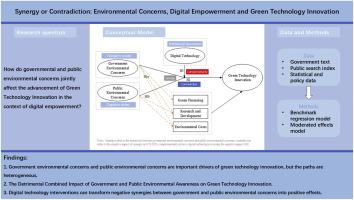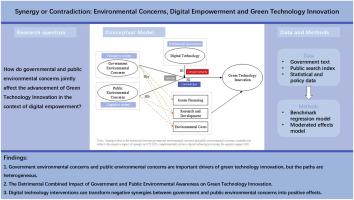协同或矛盾:环境问题、数字授权和绿色技术创新
IF 10
1区 环境科学与生态学
Q1 ENGINEERING, ENVIRONMENTAL
引用次数: 0
摘要
绿色技术创新既需要自上而下的政策干预,也需要自下而上的公众参与。本研究运用文本分析法,找出政府和公众所表达的环境关切。本文评估了2012 - 2022年中国236个城市的绿色技术创新中这些关注点各自和共同的影响。研究结果表明,公众环境关注促进了绿色创新发展,而政府关注增强了创新动力,但阻碍了创新能力的提升。进一步分析表明,公众和政府对创新能力的关注之间存在负协同效应。数字技术调节了这些关系:它对政府关注的影响产生u型效应,对公众关注的影响产生倒u型效应,使它们的互斥性转化为互补性。因此,需要通过顶层设计激活政府和公众环境关注的协同效应,构建多主体协同绿色创新生态系统,并依靠适度的数字技术赋能来克服协同障碍,为绿色创新提供系统支持。本文章由计算机程序翻译,如有差异,请以英文原文为准。


Synergy or contradiction: Environmental concerns, digital empowerment and green technology innovation
Green technological innovation requires both top-down policy intervention and bottom-up public participation. This study utilizes textual analysis to identify environmental concerns expressed by governments and the public. It evaluates the respective and joint effects of these concerns on green technological innovation across 236 Chinese cities from 2012 to 2022. The findings indicate that public environmental concerns stimulate green innovation development, while government concerns enhance innovation dynamics but hinder improvements in innovation capacity. Further analysis reveals a negative synergy between public and governmental concerns regarding innovation capacity. Digital technology moderates these relationships: it induces a U-shaped effect on the impact of government concerns and an inverted U-shaped effect on public concerns, transforming their mutual exclusivity into complementarity. Therefore, it is necessary to activate the synergistic effect of government and public environmental attention through top-level design, build a multi-agent collaborative green innovation ecosystem, and rely on moderate digital technology empowerment to overcome synergy barriers, providing systematic support for green innovation.
求助全文
通过发布文献求助,成功后即可免费获取论文全文。
去求助
来源期刊

Journal of Cleaner Production
环境科学-工程:环境
CiteScore
20.40
自引率
9.00%
发文量
4720
审稿时长
111 days
期刊介绍:
The Journal of Cleaner Production is an international, transdisciplinary journal that addresses and discusses theoretical and practical Cleaner Production, Environmental, and Sustainability issues. It aims to help societies become more sustainable by focusing on the concept of 'Cleaner Production', which aims at preventing waste production and increasing efficiencies in energy, water, resources, and human capital use. The journal serves as a platform for corporations, governments, education institutions, regions, and societies to engage in discussions and research related to Cleaner Production, environmental, and sustainability practices.
 求助内容:
求助内容: 应助结果提醒方式:
应助结果提醒方式:


